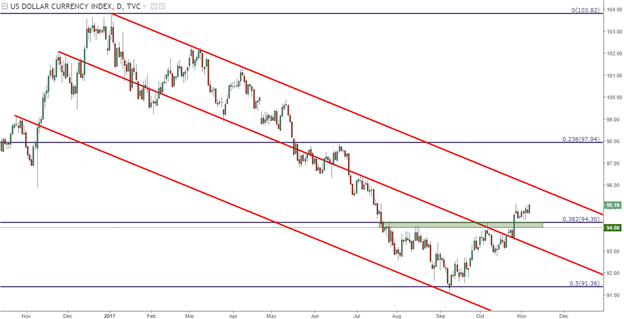In yesterday’s article, we looked at how a persistently bullish U.S. Dollar appears to be on the cusp of a longer-term bullish run. And the juncture that we presently find ourselves at really just highlights how extraordinary the year of 2017 has been. When we came into the year, the U.S. Dollar was surging while at 14-year highs, prodded by the ‘Trump Trade’ that was simultaneously driving both bond and stock markets higher. This is also when EUR/USD was a few hundred pips from parity, a level that was called by many shops as the expectation was for the Euro to just keep creeping-lower as the ECB remained dovish and passive.
But a lot has changed since January 1st, as the U.S. Dollar went on to lose as much as -12.3% of its value while the Euro spent most of the first nine months of the year trending-higher. This theme was very much being driven by the prospect of a stimulus exit or, at the very least, a taper from the ECB. On October 26th, we heard that the bank is extending their QE program to September of next year while also planning to keep rates at present levels for the foreseeable future. This effectively kicked the can on the prospect of stimulus exit from the ECB, and this nullifies one of the major drivers to the Euro’s prior bullish trend.
The big question at this point is how low EUR/USD might go? It’s widely expected that the Fed is going to hike in December and the bank continues to say that they’re looking at three more hikes for 2018. This is over a period in which the ECB is planning no such tweaks to monetary policy, and this can produce a backdrop that allows for a continuation of USD-strength and Euro-weakness as those prior trends come a bit more undone as we move towards the end of the year.
U.S. Dollar via ‘DXY’ Daily: Nine-Month Down-Trend into Fresh Three-Month Highs

EUR/USD
As we mentioned earlier, the Euro has spent most of the year trending-higher under the expectation that the ECB would tighten policy at some point. And the ECB, for the most part, has remained dovish and passive. Throughout the year, the bank has continued to say that they weren’t yet ready to discuss stimulus exit. Markets, nonetheless, continued to price-in the prospect of an eventual exit, or at the very least a taper. At successive meetings in April, June, July and August; ECB President Mario Draghi continually said that the ECB hadn’t even discussed the idea of exiting from stimulus. When we finally got to October, and when the ECB announced that they were extending their program out to September of next year – that prior theme was nullified and weakness has begun to show in the single currency.










Leave A Comment